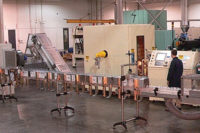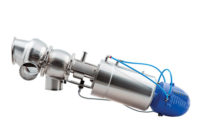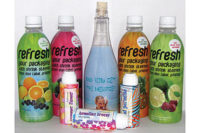Labels play an important role in the selling and marketing of dairy foods and beverages. They are often what consumers notice first, a manufacturer’s only chance to grab their attention. Labels are also a vital tool to inform the consumer about a product’s nutritional values and benefits, company history, appetite appeal and more. We spoke with label suppliers about best practices in labeling, what to do when there is a changeover for flavors and tips for storing labels.
Dairy brands require high-quality printing to stand out on the shelf and to give them a competitive edge. But thinner label stock can affect the quality of graphics. We asked suppliers how a dairy manufacturer can assure high-quality printing.
Mike Wencel Sr., owner and CEO of Wencel Design Co., Oak Brook, Ill., suggested that seeing samples from suppliers is most important, but also to give the supplier a color-matched sample approval.
Ron Giordano CEO of H.S. Crocker Co., Huntley, Ill. offered this counter argument regarding thinner stock use.
“I do not believe that thinner stock has any advantage over normal stock of the same kind,” Giordano said. “The thinner stock affords you a slightly lower price but the graphics on either can be the same unless the thinner material has a more porous face sheet that will hinder the graphic results you wish to attain.”
Yogurt and cream cheese are often packaged in containers with in-mold labeling. This allows for sharp four-color photography. We asked whether other categories (besides cultured dairy) could benefit from IML.
Wencel said that IML hasn’t been totally proven yet, but he suggested that butter and ice cream could benefit from IML.
Giordano said, “There are pros and cons about in-mold labeling. At one time in the late ‘70s and early ‘80s it was the trend. Then many found out that if the label was not positioned right the bottle had to go to regrind and that is expensive. Since then, the trend has been more toward shrink sleeves and more so with the traditional die-cut lid that says it all and is easy to handle.”
The shrink-sleeve advantage
It is said that shrink sleeves on milk bottles allow for the best execution of appetite appeal in the graphics. But shrink sleeves require heat tunnels as well as sleevers. So we asked suppliers how they would convince a milk processor to invest in this equipment.
“Shrink-sleeve labels offer many advantages to milk processors,” said Bob Williams, vice president of sales and marketing for Axon, Raleigh, N.C. “Our experience has been we really don’t have to do much convincing when it comes to investing in this equipment, because the advantages far out-weigh the costs.”
He offered these examples:
- These labels are designed to cover the entire package, providing up to 360-degree coverage. This greatly improves a company’s ability to communicate a brand’s unique message and image with eye-catching pictures, graphics or nutritional information.
- The shrink characteristics of the film allow processors to be more creative by using irregularly shaped containers.
- Shrink-sleeve applicators also offer production flexibility. For instance, with a few change parts, the same machine can apply small or large sleeves, (i.e. tamper-evident bands, partial labels or full-body sleeves.) And the applicators can be placed either in the manufacturing plant as a stand-alone operation, or integrated into a fully automatic production line.
- With a tight-fitting tamper-evident band, consumers have visual confirmation that a product has not been opened or altered. A tamper-evident band can be integrated into the full-body sleeve with an easy-opening tear strip for an attractive and safe customer experience.
“According to historic sales data, the use of shrink sleeves has resulted in across-the-board sales increases. There is nothing that compares to a shrink-sleeve label for graphic impact at the point of purchase, where most buying decisions are made,” said Neal A. Konstantin, president of PDC International, Norwalk, Conn. “The perception of a high-end product, in combination with the increased billboard space over all surfaces for color and graphics, results in a premium presentation that has real brand value.”
He added that bottles can be labeled either empty or full, giving a processor flexibility as to where decoration is best applied within its facility.
“Shrink sleeves afford a yogurt producer to not have a printed cup to eliminate waste, but then that is great for large volume, not medium or small volume,” said Giordano. “For milk bottles the least expensive is a pressure-sensitive label, no heat tunnels and no elaborate equipment. And the proper label can show off the graphics nicely. Look at some of the water bottle labels with the see-through look.”
“Investing in shrink-sleeve equipment is one of the best long-term decisions dairy producers could make,” said Yann Renard, business development manager, labelers, for Sidel North America, Norcross, Ga. “Shrink sleeves provide more real estate on the product for brand promotion while improving production sustainability. The introduction of new shrink-sleeve label substrates and labeling technologies offers significant cost-savings opportunities in label production.”
What’s best for ice cream?
Since ice cream is still being packaged in cardboard containers, we asked for tips on how ice cream processors can improve their branding with labeling technology.
Wencel suggested lithography printing and IML in plastic containers. “Also, you can shrink sleeve an ice cream tub,” he said.
Giordano said, “The cardboard container and ice cream are a go-together combo. There, improvement is on the graphics of the lid and printing under the lid for promos and ad copy that lends itself to other flavors. Go with different types of lidding foil instead of paper and let the metallic look work for you on the shelf.”
Eliminating mistakes
Ensuring that cup labels and lid labels match is important. If they don’t, processors have to issue a recall. In June 2014, Nestlé USA recalled 10,000 packages of its Häagen-Dazs ice cream due to mismatched packaging. Some 14-ounce cartons labeled as chocolate chocolate chip ice cream were topped with chocolate peanut butter lids.
We asked suppliers for examples of good practices that dairy processors could follow during a changeover for flavors.
“The fastest way for them to check their lines is to go to 2D bar codes so that there are no line mixes,” said Giordano. “All shipping cartons should have a color-coded label and a bar code. The lids and cups should have identical 2D bar codes and a simple system that states pass/fail when running on their line.”
Label storage
Conditions in dairy plants can include humidity, moisture, heat and cold. So we asked for recommendations for handling and storing labels until they are used.
Giordano said, “Label or lid storage should always be at 70F and 50RH [relative humidity] and if there is an extreme heat problem, place the cartons of lids or labels in the cooler to readjust to the environment in the plant.”
He also said to make sure lids or labels are always stored in the same environment as to where the product is being packed to be sure they are compatible.
Wencel said that dry storage and unlighted areas are the best locations for labels and milk cartons.
“Storing labels in the wrong climate may cause you to lose the level of adhering performance you desire. This in many cases is just throwing money down the drain,” said John O’Donnell, sales for EPI Labelers, New Freedom, Pa.
O’Donnell suggested that processors talk with their manufacturer to find out how they suggest storing the labels for the best results, based on the type of label being used. He also suggested bringing the labels into the actual labeling environment at least 24 hours in advance to give them time to get acclimated. n
Find more information on label suppliers in Dairy Foods' 2014 Buyers Guide.
Tips for choosing the best
John O’Donnell from EPI Labelers offered these tips for dairy processors:
- Identify your need. What is being labeled? What is the product made of? What is the application surface and condition (i.e. plastic, smooth, clean, rigid, etc.)? Where on the product do you want the label?
- Where in your production line will the labeling process take place? This will help determine the type of labeler and application needed. Knowing the labeler and application you will be using will help determine label sizes that are possible.
- What is the product’s environment? (i.e. indoors, outdoors, room temperature, freezer, etc.) This answer will help the label manufacturer narrow down what label and adhesive will work.








